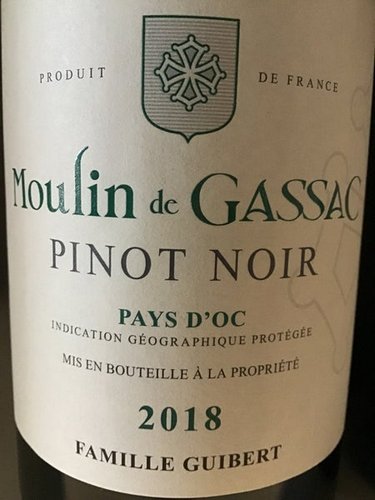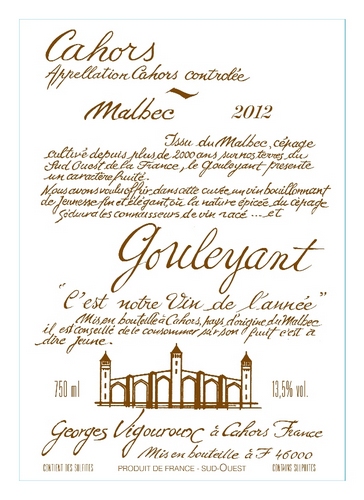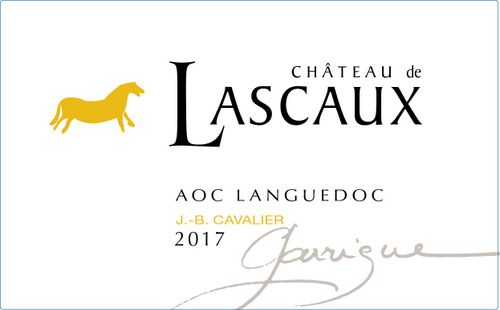Ercole Bianco
Lorelle Pinot Grigio
Moulin de Gassac Pinot Noir
Olianas Cannonau
Gouleyant cahors (Malbec)
Lascaux Rouge Garrigue

Ercole Bianco (Organic)
Weston Hoard spent four years living in Piedmont and working for renowned winemaker Paolo Scavino. When he returned to the United States in 2011, he determined to channel his experience in Italy into a new importing project which he named “The Piedmont Guy.” The company “does Piedmont,” and only Piedmont.
Ercole is a project aimed at honoring the work of the unsung heroes of Italy — the grape growers themselves. Ercole, whose English translation is Hercules, is only made possible by a generations-old cooperative of local growers in the Monferrato area. Every fall, these men and women cultivate bright and balanced fruit, allowing us to make real wines that are transmitters of time and place. The place, Monferrato, ranks among the most historic grape-growing areas of Piedmont. The fruit from this overlooked area gives us Ercole, a family of wines offering remarkable value. Enjoy these one-liter, screw-top bottlings unconditionally. Salute!
The cooperative behind Ercole works predominantly with old vines ranging from 30 to 50 years old. All participating growers adhere to the European Union rule for sustainable farming known as lotta integrata, or lutte raisonnée, though many are now certified organic. None of these growers use systemic treatments or chemicals, employing only minimal copper and sulfur. Both vinification and bottling are certified vegan.
The place, Monferrato, ranks among the most historic grape-growing areas of Piedmont and is the confirmed birthplace of the Barbera grape. For these reasons, we work primarily with Monferrato’s indigenous grape varieties. The fruit from this increasingly popular area gives us Ercole, a family of wines offering remarkable value.
At their best, wines made from the native grape variety Cortese boast a serious yet pleasing weight, pronounced minerality, and beautiful acidity. In fact, the Cortese-based wines of nearby Gavi are among the most treasured whites of Northern Italy. We have discovered that adding a touch of Chardonnay and Sauvignon Blanc further sharpens and thereby elevates this wine.

Lorelle Pinot Grigio (Sustainable)
Lorelle is produced from a small, family-owned and operated winery. Better known as the people behind Six Peaks Winery, founders, John and Lynn Albin (UC Davis), along with their son, Andrew Albin (OSU), work together to produce Lorelle, which are both true to variety and excellent companions with food.
After a long stint as winemaker at King Estate, John planted his own vines at Laurel Vineyard in 1981. Nearly a decade later they expanded from viticulture to winemaking. Throughout John’s long winemaking history in the Pacific Northwest, he has had many opportunities to work with and befriend many talented farmers. These relationships are part of what makes Lorelle so special. They not only meticulously tend to their own vineyards for this project, but they also source some of the best fruit from the best growers year after year to make wines that are consistently delicious.
Flavors of pear, stone fruit and green apple. This wine is conventionally dry, but has enough ripeness to balance the wine’s natural acidity making it well-rounded and easy to enjoy. The fruit for this wine comes from den Hoed Vineyard, within the Columbia Valley AVA, where it is a little cooler than other locations in the area. This cooler climate vineyard gives the wine unique freshness and bright acidity. This fruit is machine harvested so it is imperative that it goes immediately to the winery, this is why they ferment the grapes near the vineyard site in Richland, WA.
Moulin de Gassac Pinot Noir (Organic and Biodynamic – with natural techniques/minimal intervention and little SO2)
As a wine-growing district, Languedoc-Roussillon has had to struggle somewhat. However, the area’s reputation as a mass producer of simple bulk wines is beginning to wash off and the district seems to be producing one brilliant wine after the next.
Wine enthusiasts have a real interest to explore among the thousands of vineyards in this area, the largest wine-growing district in France. The history of Mas de Daumas Gassac is quite extraordinary: In Millau, a little way up in the Cevennes, there is a more than 300-year-old family company producing gloves and other leather goods.
In 1970, the boss, Aimé Guibert and his wife Veronique, acquired what was then a very run-down vineyard – a mas – between the town of Gignac and Aniane, just west of Montpelier. They had a dream of growing good quality wine and knew that the soil at the foot of the Gassac hills would be suitable for this purpose.
What started off as a dream in 1970, the “country wine” of Mas de Daumas Gassac has now grown into one of the finest wines in the world. The Herault’s most famous estate, Mas de Daumas-Gassac is often referred to as ‘the Lafite or First Growth of the Languedoc’ – their wines have achieved ‘cult’ status.
Several years back, the folks at Mas de Daumas Gassac began working with a neighboring cooperative in Sête to produce fun, full-flavored wines from the surrounding countryside and rocky hillsides. The goal is to produce wines grown under the strict vineyard and winemaking regimens employed at this unique domaine.
Organic farming is de rigueur and the vinification is closely overseen by the Guibert family. The results are splendidly aromatic wines that bring out the terroir of this Mediterranean region.
Having spent several years looking for the right provenance for Pinot Noir grapes to add the varietal to their highly successful line of Moulin de Gassac wines, the Guibert family finally opted for the terroir of Cournonterral in the Herault valley, just a few kilometers from the Mediterranean sea. Here they are able to produce a fine, elegant medium-bodied Pinot Noir with perfect balance (only 12.5% alc) at the perfect price. The classic Pinot nose of bright candied cherries and hints of roasted fruit and mocha lead into a fresh mouthwatering wine with soft tannins and a persistent finish. This wine will keep you coming back for more.

olianas cannonau di Sardegna – organic and biodynamic
Cannonau is most closely associated with the island of Sardegna where it is widely planted. Cannonau is used to make dry reds, rose’, passito sweet wines, or fortified “liquoroso” wines.
It has long been thought that the variety arrived on Sardinia with the Aragonese when they conquered the island in the early 14th Century (from what is now Aragon). However, in the past few years, Italian researchers have uncovered evidence suggesting that Cannonau (and therefore Grenache) may well have originated in Sardinia.
Made with Cannonau (aka Grenache or Garnacha) which is Sardinia’s main red variety. Low yielding vines are hand harvested and then 70% of the wine is made in stainless steel vats, the other 30% is fermented in amphorae – the final wine is blended and aged for 3 months in oak. This is a wine with personality and energy – lots of blueberry, umeboshi plum, sweet spice, toast, tobacco and violet. The wine weighs in somewhere between medium and full body with a freshness that makes you want to go back for more.
Native yeast, low sulfur additions, tank fermented and finished in oak and amphora, Organically farmed. An intense ruby red, fresh, boldly structured flavors. An explosion of small berries with hints of dark chocolate and tobacco is followed by silky tannins and excellent flavor concentration. Well balanced by the pleasant acidity. A young, fresh and lively wine, ideal with appetizers and main courses.
Azienda Agricola Olianas is all about native grape varietals. The winery is located in Gergei, Sardinia, in central, southern Sardinia, a particularly unspoiled part of the island. Olianas is planted with Cannonau (Grenache), Carignano (Carignane), Bovale, Vermentino and Nasco, all indigenous grape varietals to the region. Olianas has 40 acres of organically farmed vineyards planted.
Georges Vigouroux Cahors, Gouleyant (Malbec) – Sustainable with Organic practices – vegan
Gouleyant is French argot for what we’d call gulpable or easy-to-drink, and this 85% Malbec, 15% Merlot blend from Cahors is certainly that.
Grown on the highest clay and gravel terraces in the Cahors appellation of Southwest France, where Malbec has been cultivated for over 2000 years, this wine is dark cherry red in color. The nose is typical of the Malbec variety with notes of ripe red and black fruits (cherry, blackberry, raspberry). The mouth is also very fruity and finishes on soft and elegant tannins.
Surprising, plump and totally pleasing, this Malbec over-delivers. Pretty violet notes on the nose mingle freely with black currant; the palate, initially soft leads into roughened tannins that creep up on the finish. Pair with spicy steak or duck. Begins with an inviting blackberry and other ripe, dark fruit aromas along with a little licorice. It’s a bit funky when first popped open but it comes around nicely.
Lascaux Garrigue Rouge (Organic and Biodynamic)
The vineyards of Château de Lascaux have been in the family for thirteen generations. The name of the domain, “Lascaux” comes from a limestone specific to the domain’s vineyard sites.
Jean-Benoît Cavalier took direction of the property in 1984, just after finishing a degree in Agricultural Engineering. In 1990, he consolidated the vineyards, restructured the ancient cellars, and created the official domain, Château de Lascaux. Today, over twenty-five years later, the domain has expanded from 60 to 210 acres of vineyards, surrounded by 750 acres of forest, filled with green oaks, pines, and garrigue**.
The quiet isolation of this part of the region, coupled with its proximity to both the sea and the mountains, makes this microclimate so unique. It is nestled along the foothills of the Cevennes, a mountain range that sits in the heart of the Midi. These foothills protect the vines from the cool Mistral and Tramontagne winds and bring more rain to an otherwise dry climate. That this temperate zone brings a long, slow ripening of the grapes only adds to the wines’ complexity. The stony soil lends finesse and freshness to his wines, giving the reds greater aging potential than Syrah-based wines grown in other Languedoc soils.
The proliferation of garrique certainly is reflected in the aromatics, where notes of laurel, thyme, rosemary, réglisse, and mint are present in the wines. Jean-Benoît is passionate about supporting the richness and diversity of this ecosystem, so the domain’s conversion to organic viticulture was a logical choice. There is a freshness and purity, finesse and complexity in the Lascaux wines that is rare in this wild landscape. The consistency of the winemaking, the quality of their wines, and great values they present make this domain a treasure.
This blend of Syrah, Grenache, and a skosh of Mourvèdre is filled with interesting garrigue flavors including ripe red fruits, dried herbs, and licorice. It is a medium-bodied red with notes of black olive, spice, and black pepper on the finish. Pair with pork, grilled red meat, or strong cheeses.
**Garrigue refers to the low-growing vegetation on the limestone hills of the Mediterranean coast, not the limestone itself. There are a bunch of bushy, fragrant plants that grow wild there, such as juniper, thyme, rosemary, and lavender, and garrigue refers to the sum of them




